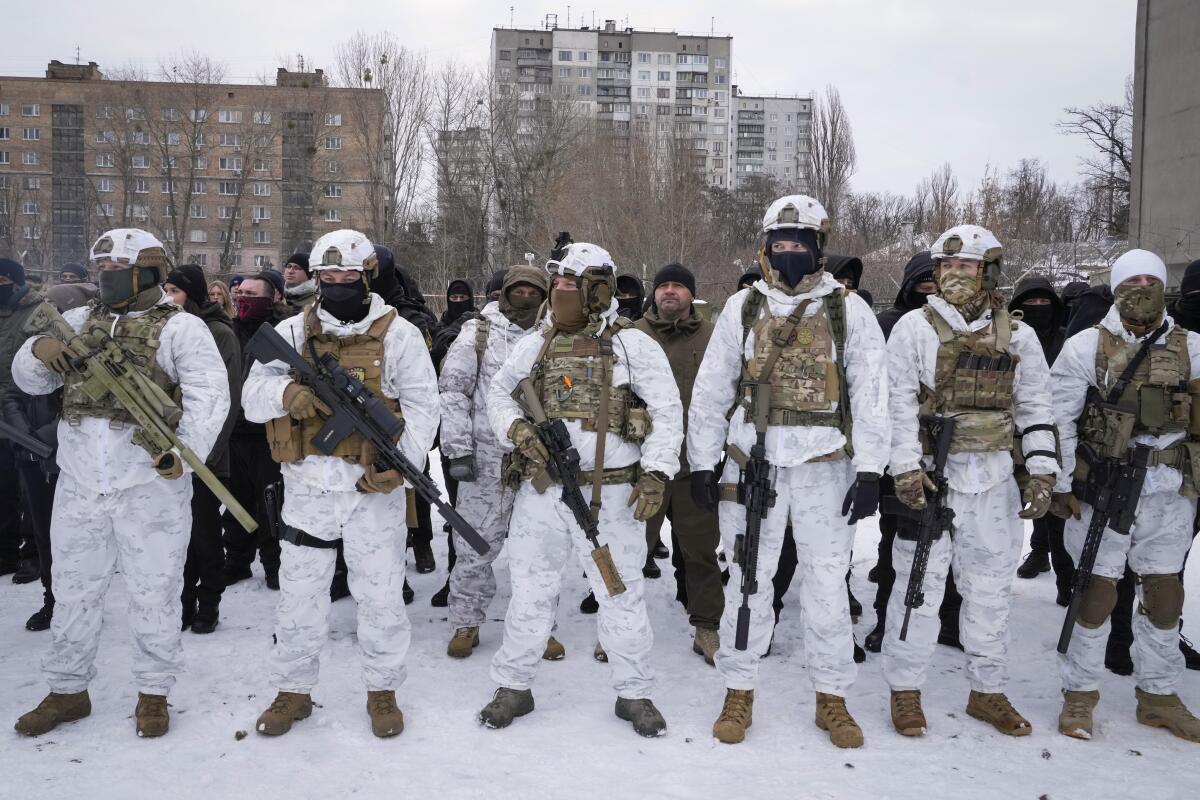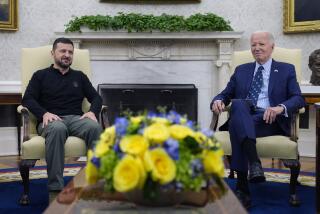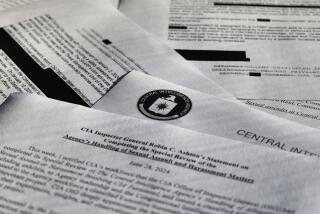Op-Ed: The CIA has backed Ukrainian insurgents before. Let’s learn from those mistakes

- Share via
As Ukraine burns, it looks as though the CIA has gone cold — back to the Cold War.
Russia invaded Ukraine by land, air and sea on Thursday, but for years now the Central Intelligence Agency has been preparing for such a moment, not only with prescient intelligence gathering and analysis but also by preparing Ukrainians to mount an insurgency against a Russian occupation.
A news story last month revealed that the agency has been training Ukrainian special forces and intelligence officers at a secret facility in the U.S. since 2015. Some U.S. officials have played down the report by claiming that the CIA is simply training the Ukrainians in intelligence collection. Others say the program has another secret purpose, which I believe: preparing Ukrainians for an insurgency in the event of a Russian occupation.
In the Yahoo News report, one former senior intelligence official explained, “That’s where the agency’s program could have a serious impact.” Likewise, other commentators have expressed hope regarding the outcome of a U.S.-backed insurgency.
Those optimists seem to be forgetting the lessons from past U.S. efforts, including the CIA’s first attempt to support a Ukrainian insurgency against the Soviets in 1949, which ended in failure and a judgment by the CIA decades later that the effort was “ill-fated and tragic.”
The challenges for a Ukrainian insurgency are no less difficult today.
Russian intelligence poses a serious threat to any CIA intervention. After initial setbacks, Soviet intelligence was able to penetrate the Ukrainian resistance, leading to the collapse of the insurgency in the early 1950s.
If Russia had been unaware that the CIA was preparing Ukrainians for an insurgency, it certainly knows about the program now. It’s been reported in the media, and if journalists were hearing about it, it is likely that Russian intelligence was aware of it as well. Perhaps the leak of the CIA program was meant to “signal” Russia that it would face a CIA-backed insurgency if it invaded Ukraine, but Russian intelligence would already have been preparing to compromise or neutralize any resistance leaders. They will certainly be high on the “kill list” Russia is said to be compiling in the event of a military occupation.
The CIA has recently been struggling to protect its foreign agents. In October 2021, the agency sent a top secret cable to its stations and bases around the world warning that dozens of sources were being captured, killed or turned into double agents. China, which has dismantled CIA networks and blown the identities of CIA officers, could help Russia in its hunt.
An insurgency will result in immense civilian suffering. CIA involvement gives Russia an even better pretext to target the general population. The Soviet Union imprisoned, massacred and deported hundreds of thousands of Ukrainians as part of its counterinsurgency campaign during the early Cold War. Because the CIA training program is now publicly known, Russia can persuasively claim that Ukrainian insurgents are CIA proxies — a useful statement as propaganda to pro-Russian separatists in eastern Ukraine and as a justification for any harsh measures it takes against Ukrainian civilians to “root out” the saboteurs.
The CIA must be realistic about the prospects of a Ukrainian insurgency. In 1950, only a year after the first CIA operation began in Ukraine, U.S. officers involved in the program knew they were fighting a losing battle. Today, we have no clear evidence that the Ukrainians are capable of sustaining an insurgency, or that Russia would retreat if faced with such resistance.
The CIA needs to be honest with the Ukrainians — and itself — about the real intent. In the first U.S.-backed insurgency, according to top secret documents later declassified, American officials intended to use the Ukrainians as a proxy force to bleed the Soviet Union. This time, is the primary goal of the paramilitary program to help Ukrainians liberate their country or to weaken Russia over the course of a long insurgency that will undoubtedly cost as many Ukrainian lives as Russian lives, if not more?
Even if a Ukrainian insurgency bleeds Russia over years, the conflict could cause instability to spread across Central and Eastern Europe. This is a pattern in the history of U.S. paramilitary operations — from the Cold War to Afghanistan and Iraq today. The risk grows exponentially when the U.S. or other outsiders funnel weapons to proxy fighters because those arms can end up in the hands of terrorists, militias or other factions for decades to come. There is also the danger that a proxy war in Ukraine could unintentionally lead to an actual war between the U.S. and Russia.
The U.S. should clearly convey to the Ukrainians the limits of its commitment. It did not do so in 1949. John Ranelagh, a historian of the CIA, argued that the program “demonstrated a cold ruthlessness” because the Ukrainian resistance had no hope of success without wider U.S. military involvement, and so “America was in effect encouraging Ukrainians to go to their deaths.” President Biden said on Thursday that U.S. troops were “not going to Europe to fight in Ukraine.” If that’s true, CIA support will probably not be enough to save Ukraine.
We don’t have to look back decades or even years for relevant lessons. Just six months ago, as the Taliban took control of Afghanistan, the CIA found itself scrambling to save its Afghan allies. Instead of supporting an insurgency as intended in Ukraine, the CIA could find itself launching a rescue mission.
Jeff Rogg is a historian of U.S. intelligence and an assistant professor in the Department of Intelligence and Security Studies at the Citadel. @TheSpyTheState
More to Read
A cure for the common opinion
Get thought-provoking perspectives with our weekly newsletter.
You may occasionally receive promotional content from the Los Angeles Times.










